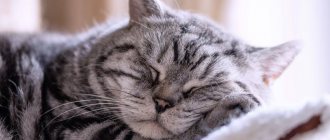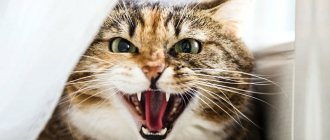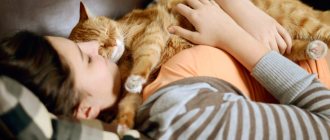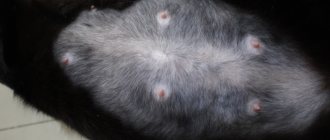7591Administration
The question of sterilizing a cat sooner or later arises before every owner. A cute pet from a quiet animal suddenly becomes very aggressive, and even the neighbors are bothered by constant loud purrs, and the point is not at all in changes in character, but in the fact that the nature of the animal is ready for procreation. But often it is not possible to find a worthy “spouse” or the owner simply does not want to give the kittens a home.
Then sterilization comes to the rescue - an operation that has been successfully performed by veterinarians around the world for many years, which can sometimes result in problems with the character and behavior of the animal - the cat sleeps a lot after sterilization or, on the contrary, is aggressive.
What is the essence of sterilization?
Surgery involves removing just the uterus or ovaries, or both, to permanently eliminate sex drive when cats are out and causing unwanted pregnancy. Sometimes tubal occlusion is performed when the organs are ligated. This is safer than monthly use of hormonal drugs that suppress sexual instinct. Veterinarians consider the optimal age to be 6-8 months, after the first heat, when the animal’s body has formed and hormonal levels have normalized. The age limit is 1 year. The operation itself lasts 15-20 minutes. and is performed under anesthesia. Cats are castrated. After the intervention, the veterinarian gives painkillers and hemostatic injections.
The cat is shaking on day 2
Signs of hypothermia, intoxication and pain accompanied by trembling may persist for 2 days after sterilization.
You can alleviate this condition:
- the use of painkillers approved by a doctor;
- rubbing paws;
- placing a heating pad under the cat's back;
- drinking plenty of water.
Sometimes, to quickly relieve intoxication, veterinary specialists perform intravenous injections with saline and glucose.
Lack of vitamins and minerals
If there is a lack of B vitamins, calcium and magnesium in the body, the cat develops nervous phenomena, manifested by muscle tremors (shaking) and convulsions. Despite the fact that hypovitaminosis develops gradually, the owner may not notice its clinical signs for a long time. But severe stress and anesthesia provoke a sharp deterioration in the female’s condition and the appearance of pathological symptoms immediately after sterilization.
This problem can be eliminated by introducing vitamin and mineral supplements into the diet, selected taking into account the age, body weight and breed of the cat.
Dangerous pathologies accompanied by lethargy
If the cat remains lethargic within 5 days after sterilization, this may indicate the development of serious pathologies.
Intra-abdominal bleeding
The presence of this complication is indicated by the following symptoms:
- bloody discharge from the vagina or postoperative suture;
- pain in the abdominal area;
- abdominal wall tension;
- pallor of mucous membranes.
Only timely surgical intervention can save a cat’s life.
In case of severe blood loss, the animal is prescribed hemo-restoring therapy.
Strangulated hernia
The discovery of a protrusion near the postoperative suture indicates the formation of a strangulated hernia. In this case, the female experiences a lack of appetite, constipation and vomiting. The lump itself is painful, hot to the touch, and has a reddish-bluish tint.
The absence of urination may indicate infringement of not only the intestinal loops, but also the bladder. The lack of surgical intervention inevitably leads to death.
Peritonitis
The development of a severe inflammatory process in the abdominal cavity may be a consequence of:
- falling of pathogenic microflora into the wound during surgery;
- necrotic damage to an area of the intestine due to a hernia;
- violation of the integrity of the bladder or intestines during surgical procedures or as a result of a strong blow and compression of the female’s abdomen;
- intra-abdominal bleeding.
The cat's temperature rises, there is a refusal to eat and severe abdominal pain. Treatment is surgery and antibiotic therapy. But you should know that the mortality rate with peritonitis is very high.
Thromboembolism
Neutering can cause a cat to form a blood clot in a large artery or vein, which can then travel and block smaller blood vessels.
Depending on the location of the thrombus, general lethargy is combined with the following clinical signs:
- violation of movement coordination;
- paralysis of the hind limbs, accompanied by stiffening of the muscles;
- blockage of the renal arteries is accompanied by symptoms of intoxication and severe pain in the abdominal area;
- a blood clot in the vessels of the brain manifests itself in epileptic seizures and coma;
- partial obstruction of the pulmonary arteries reveals itself with a severe cough, pallor of the mucous membranes and characteristic swelling of the jugular vein;
- vomiting and diarrhea mixed with blood indicate damage to the mesenteric arteries.
This serious disease can be treated surgically, but there is a high mortality rate. Fortunately, thromboembolism is a rare disease, but it is important for the owner to be aware of the possibility of its occurrence in order to pay attention to alarming symptoms in time.
the cat sleeps a lot and is lethargic after sterilization
ZooForum: Cat After Sterilization Lethargic. — ZooForum
(others can give advice in a PM, indicating that the advice is not given by a veterinarian. But the forum is not responsible for THESE advice.)
Possible problems and tips for caring for a cat after sterilization
What is sterilization? This is the removal of an animal's reproductive organs. The main feline egg-producing organs are the ovaries. The operation to remove the ovaries is considered simple, is accompanied by an incision in the abdomen, with the use of anesthesia and takes from 10 to 15 minutes, after which care for the cat
after sterilization must be carried out by its owner.
It is extremely rare for complications to occur after sterilization of a cat or castration of a cat. How long does it take for a cat to recover from anesthesia after sterilization and what to do if your pet still develops a lump at the site of the suture, constipation or diarrhea begins, the mammary glands are swollen, or the cat no longer eats, or drinks little water, or sleeps all the time and has a fever Body temperature?
If this condition continues throughout the day, a mandatory consultation with a veterinarian is required. If you are worried about how to care for your cat after sterilization, then by following certain recommendations you will help her quickly recover from surgery and anesthesia and return to a healthy, happy life.
Sometimes after surgery, an animal’s internal organs fall out into the subcutaneous sac, which is a hernia. When the internal seams diverge, a lump of different sizes appears. During a careful examination of the animal’s seams, one can observe the following: a whole thread with which the seam was correctly sewn up, intact external seams, and a lump still appears next to it, which is a kind of bulge without pus and inflammatory symptoms.
One of the main reasons for the appearance of a lump is rapid resorption
Source
Day five
Again this girl took off her blanket at night. Good girl, the cat needs to wash herself. This time it was easier to put it on Alice. When they dressed her on Wednesday, the cat’s body was somehow tense, but now it’s softer. Eh, I have to wait another week before the stitches are removed. I don’t see what’s going on with her.
Blanket inside
Today she no longer lies on the rug in the hallway, she moved into a house with toys. He sleeps there. But when I looked at her, it turns out that she had pulled the blanket off the wound and was licking her seam. Such a hooligan. I had to tie it tighter.
Aliska feels calmer with soft toys
And in the evening she fiercely licked the blanket at the seam. Apparently the wound is healing and itching.
Postoperative care
As a rule, during the sterilization of cats, specialists use gas anesthesia. Despite the fact that animals tolerate it quite easily, after the operation is completed, pets need some time during which they will “recover” from anesthesia.
The effect of anesthesia manifests itself in impaired coordination of movements, so the cat should be placed in its usual resting place and its communication with other pets or children should be limited.
During the period when the cat recovers from anesthesia, which lasts about a day, the pet should not be placed on high surfaces. Impaired coordination of movements can lead to the animal falling from a height. It is recommended to lay a diaper in the cat's resting place, which will protect the bedding in case of possible attacks of vomiting.
Place a bedding on the floor, possibly near the radiator
Features of feeding
At the end of the rehabilitation period, the animal becomes completely healthy, which means that its diet should be the same as before the operation. Very often, a sterilized cat begins to eat more than usual, as a result of which she quickly gains weight. The owner should pay attention to this and limit the intake of smoked, fatty, salty foods, as well as pasta, beans, fish and bread.
Obesity of a cat after sterilization
To prevent constipation, dry food offered to your pet should be pre-soaked. To prevent your cat from gaining excess weight, you need to play with it more than before.
The cat is shaking on day 2
Signs of hypothermia, intoxication and pain accompanied by trembling may persist for 2 days after sterilization.
You can alleviate this condition:
- the use of painkillers approved by a doctor;
- rubbing paws;
- placing a heating pad under the cat's back;
- drinking plenty of water.
Sometimes, to quickly relieve intoxication, veterinary specialists perform intravenous injections with saline and glucose.
Lack of vitamins and minerals
If there is a lack of B vitamins, calcium and magnesium in the body, the cat develops nervous phenomena, manifested by muscle tremors (shaking) and convulsions. Despite the fact that hypovitaminosis develops gradually, the owner may not notice its clinical signs for a long time. But severe stress and anesthesia provoke a sharp deterioration in the female’s condition and the appearance of pathological symptoms immediately after sterilization.
This problem can be eliminated by introducing vitamin and mineral supplements into the diet, selected taking into account the age, body weight and breed of the cat.
Cat behavior during the first knocks and days after sterilization
If the operation was successful and was carried out by a qualified doctor, the pet will sleep on the first day. The cat is considered to have recovered from the anesthesia as soon as it raised its head and was able to roll over. Typically, the animal emerges from a state of deep sleep within a few hours after the administration of anesthesia.
During the first day, the cat may refuse food and water - this is considered normal. For 24–36 hours after surgery, it is necessary to keep the cat in a warm room, and if necessary, on a heating pad. All medications used to induce sleep affect heart function and thermoregulation. Immediately after surgery, your cat may become hypothermic, even in hot weather.
Strange behavior of a cat after sterilization - what to prepare for?
Strange behavior of a cat after sterilization, especially in the first few days, is considered normal. All substances that put a cat under anesthesia are narcotic and can cause unexpected complications. The most common consequence that provokes inappropriate behavior is hallucinations.
When recovering from anesthesia, a cat may suddenly jump up, start running and jumping out of windows. Make sure that all the windows in the room are closed and that the pet cannot run out the front door. Unfortunately, many owners have experienced their pets falling out of the window immediately after the anesthesia came off.
In addition to excessive activity, a cat recovering from anesthesia may begin to behave aggressively. You will notice that the pet strongly beats its tail and growls. At the same time, the cat ignores the owner’s voice and stares into space. In this state, it is almost impossible to reach the pet’s consciousness, so try to protect it from self-injury and do not interfere in the process. If the cat is in a calm environment and is not irritated by additional factors, it will very quickly calm down and go to sleep.
Cat behavior on the second and third days after sterilization
On the second day after sterilization, if everything goes well, the cat should get some sleep and become interested in food. Don't panic if your cat isn't eating but is actively consuming water. In the first days after the operation, a single vomiting or slight disturbance of the gastrointestinal tract is considered normal.
Try to protect your pet from stress as much as possible, as she will feel weak and drowsy. Due to the peculiarities of psychology, cats cannot fall asleep deeply if they are in an unsafe environment. Try not to disturb your pet unnecessarily and make sure that the seam remains dry after sterilization.
On the third day after surgery, the cat must begin to eat. Try to feed your pet soft and easily digestible food. Your goal is to create a diet so that your cat does not form hard feces. Pushing during defecation leads to tension in the peritoneum and can interfere with the speedy healing of the suture.
The effects of narcotic drugs are reversed using antidotes, but almost every drug has a unique detoxification therapy.
Cat behavior during recovery from anesthesia
During recovery from anesthesia, the cat sleeps most of the time. After waking up, the owners may notice lethargy in the pet’s movements, an uncertain, unsteady gait caused by general weakness of the body (see what a cat’s behavior should be after sterilization).
There is no need to worry, as this is a normal course of the process of coming out of a drug-induced state. During this period, it is necessary to carefully monitor the pet, do not allow it to hide or climb too high.
It is not recommended to feed the cat on the first day after the operation, but the animal needs clean drinking water. You can switch to a traditional diet only after the pet has finally recovered from the effects of sterilization. At first, the food should be light, its quantity small. Otherwise, constipation will have to be treated. If the animal does not want to eat, you should not try to force feed it.
It is very common for cats to tremble after sterilization. In this case, there is also no need to worry, since trembling is a consequence of a violation of the body’s thermoregulation caused by surgical intervention.
The owner of the animal must arrange for it to rest in a warm place, cover it with a blanket and place a bowl of warm water in the resting place.
Should you worry about rising temperatures?
In the first days after surgery, an increase in the animal’s body temperature can be observed, which is associated primarily with the reaction to tissue damage and the reactivity of the body. An increase in temperature is not a sign that the animal is sick or has contracted an infection, but only a protective reaction, since the operation is accompanied by damage to the skin. This problem is often associated with the fact that the cat sleeps most of the time.
shutterstock
To help your pet, you need to give him painkillers to help lower his temperature. If this continues after 5 days from surgery, you should contact your veterinarian.
What medications can be used to alleviate the condition?
- Antibiotics. With a high-quality operation, a long course of antibiotic treatment is not needed; one prophylactic injection is enough. If any complications occur, you should definitely consult a doctor before using antibiotics.
- Vitamins. If drowsiness can be noticed in sterilized cats, behavior remains inactive and there is a clear weakening, a fortified course is needed to generally strengthen the body, which, again, should be prescribed by a veterinarian.
- Hemostatic drugs. They are used if poor blood clotting is noticed and bruising is noticed around the suture in the following days.
- Any other medications can be used depending on your case, since the body of each animal is individual and it is impossible to predict what exactly will be needed.
https://youtube.com/watch?v=7limA9Ts2AQ
Day eleven, removal of stitches
Before the hospital I put a blanket on Alice, she struggled and ran away, but I managed. I also didn’t want to get into the carrier. She meowed pitifully all the way. There's another nurse there again. She ruined the whole impression of the hospital; if the doctor and nurses were friendly and inviting, then this woman amazed me. She didn’t let me take off the blanket herself; she demanded that I take Aliska by the scruff of the neck. When I didn’t understand, she picked it up by the fur herself. I categorically refused to do this. The nurse grumbled that the cat would scratch her. And I was “scratched” by the negativity coming from her.
The stitches were removed quickly, the nurse and I held, and the doctor removed. They paid 100 rubles to remove the stitches.
The threads are pulled out
What can I do to help my animal get back to normal faster?
First of all, there is no need to panic. If the owner runs around his pet, nothing good will come of it. The animal will only get nervous and get even worse. So what to do in such situations?
Here is a list of necessary actions:
If the owner is confused by anything in the appearance or behavior of the cat (with the exception of lethargy), you should immediately arrange with a veterinarian to examine the animal.
It is necessary to create the most favorable living conditions for your pet. It is highly advisable to place the cat in a separate, isolated room where no one will disturb it.
For the first three days, we recommend feeding your cat rich chicken broth. This way the load on her digestive system will be minimal, which will allow the body to free up resources for full recovery.
Sterilization of a cat. Before and after.
12-14 hours before the operation, do not give the cat food, and about an hour before the operation, remove the water, since the stomach, intestines and bladder should be empty. Purchase 2 postoperative blankets in advance, make sure that there are no threads sticking out of them, since the cat can pull them out and swallow them.
Day ten
In the morning, our cat was again without a blanket, so I quickly put it on for her. And then we see, she’s hallucinating again. He walks backwards, then they realized that it was just the blanket that was in the way, that it was put on incorrectly. We decided to take it off and not wear it again. The cat immediately became playful, runs around the house, has fun, and grabs our legs with its paws. The appetite is excellent.
The threads are sticking out
Day three
We woke up in the morning, the blanket was lying somewhere, and Aliska was sitting there licking her wounds. I'm shocked! They grabbed this weightless miracle and with difficulty put on the blanket. Most likely it’s wrong, but today we’ll get an antibiotic injection, they’ll tell us. In general, I read in people’s reviews that you can put a nylon stocking on a cat after cutting it out, she definitely won’t take it off. I also saw on the Internet special collars for the neck, with them she will not be able to reach the seam.
I pushed her into the carrier with difficulty, she desperately struggled and meowed. We went for an injection, it’s strange that the doctor scheduled it for someone other than her shift. The nurse looked at the suture and said everything was fine. I treated it and then gave it an injection. We paid another 148 rubles for this.
I asked the nurse about the tights. She was indignant - these are synthetics, they don’t breathe, the cat will snort under them, and then she will have to treat them.
I also forgot to ask what kind of surgery it was, did they just cut out the uterus? Or along with the pipes?
Now it’s only the 23rd to go to the doctor to have the stitches removed, how will we survive the week and one day?
In the morning Aliska also had an appetite, but after the injection it disappeared again. And, in general, my health worsened. She again lay with her eyes open and did not eat anything. And the cat began to walk backwards.
Receipt for an antibiotic injection
The first day. Cat sterilization
Aliska was weighed - 2500. They said that the weight is normal for an eight-month-old cat, although she seems too thin to us.
Weighing is carried out to determine the dose of anesthesia
They quickly gave two injections, she didn’t even have time to flinch. They put him back in the carrier. They filled out all the papers and sent us out for an hour. About 50 minutes later they called and said that we could pick up the cat. They came for her, they were sure that Alice was sleeping, but she was sitting in the carrier with her eyes wide open. It turns out she was given an injection to bring her out of anesthesia.
We paid 3400 rubles for sterilization.
The price includes a blanket, syringes, etc.
They brought it home and sat quietly in the carrier. From us to the veterinary clinic is a 15-minute walk.
They immediately let him out of the house, the poor fellow is dressed in some kind of blanket, walks staggering, or moves around rolling on the floor.
The first minutes at home after sterilization
She gave me some water from my hand, I felt a little nauseous.
I slept mostly in a tent house next to soft toys.
Should you worry about rising temperatures?
In the first days after surgery, an increase in the animal’s body temperature can be observed, which is associated primarily with the reaction to tissue damage and the reactivity of the body. An increase in temperature is not a sign that the animal is sick or has contracted an infection, but only a protective reaction, since the operation is accompanied by damage to the skin. This problem is often associated with the fact that the cat sleeps most of the time.
What medications can be used to alleviate the condition?
- Antibiotics. With a high-quality operation, a long course of antibiotic treatment is not needed; one prophylactic injection is enough. If any complications occur, you should definitely consult a doctor before using antibiotics.
- Vitamins. If drowsiness can be noticed in sterilized cats, behavior remains inactive and there is a clear weakening, a fortified course is needed to generally strengthen the body, which, again, should be prescribed by a veterinarian.
- Hemostatic drugs. They are used if poor blood clotting is noticed and bruising is noticed around the suture in the following days.
- Any other medications can be used depending on your case, since the body of each animal is individual and it is impossible to predict what exactly will be needed.
https://youtube.com/watch?v=7limA9Ts2AQ
Behavior of cats after sterilization. Caring for a cat after sterilization
More and more often, owners ask themselves the question: “Should I sterilize my cat?” And this approach is more correct than the use of hormonal contraceptives or a complete refusal to regulate sexual activity. The fact is that medications negatively affect the cat’s health, can lead to various tumors, etc. And in the second case, there is a threat that the animal will become pregnant several times a year. Neutered cats walk around and do not produce any offspring. The operation eliminates all questions and problems once and for all.
Seam care rules
Many pets are bothered by the stitch, so they try to get rid of it by licking and scratching the wound. The owners must stop such attempts immediately. The fact is that in the claws and saliva of animals there are many different bacteria that can provoke one or another infectious disease.
It is necessary to ensure that the cat does not touch the wound, but it is better to cover this area with a blanket or a special bandage. The dressing must be changed periodically. If you use blankets, there should be two of them so that one of them can be washed in a timely manner. If the suture causes great discomfort to the animal, a special collar or bandage will help limit access to the wound. The postoperative suture heals quite quickly.
The bandage can be purchased at any veterinary pharmacy
As a rule, on the third day the wound is no longer noticeable, and after another week the skin in this place is completely restored.
The seam must be periodically treated with antiseptic agents. If inflammation, crusting, redness or swelling occurs, take your pet to a specialist immediately. He will eliminate negative manifestations and provide recommendations regarding proper care of the postoperative suture.
Also, the veterinarian may prescribe the following medications:
- antibiotics when the animal scratches or licks a wound;
- special medicinal ointments for the skin to prevent itching;
- hemostatic drugs in case of slow blood clotting;
- vitamins that will allow your pet to regain its former strength and mobility in a short time.
The first week after sterilization: norm and pathology
If your cat is feeling well and running and playing for a couple of weeks after surgery, even if she suddenly stops eating, this is unlikely to be due to complications from surgery. The owner must remember that all serious complications of a poor-quality operation will certainly appear within the first three days. In milder cases (inflammation of a suture, for example), this period increases to a week, but no more.
First day
The most important period. But, given the topic of our article, it’s the simplest. The fact is that approximately 70% of cats undergoing abdominal surgery have no appetite on the first day. They have not yet recovered from the effects of anesthesia; they do not want to eat. Accordingly, there is nothing to worry about.
On the first day after surgery, the cat must do two things: drink and pee. If the cat wants to eat, you can give it 10-20 ml of low-fat chicken broth (preferably from a syringe, watching for swallowing movements). For the first time this is quite enough.
Second day
Unlike the first, day 2 is often the “moment of truth.” If the operation was performed poorly, then the consequences of surgery are already beginning to appear in all their glory. Not all cats eat voraciously by this time. It happens that on the second day the pet refuses to eat.
But in this case the animal must:
- Be active enough and not lie down.
- Good to drink.
- Have no problems with urination.
- The suture line cannot show signs of severe inflammation; only dried ichor streaks are acceptable.
If the cat matches the description, then everything is probably fine with it.
The third day
But in cases where day 3 is accompanied by a continuation of the “fast,” then something is clearly wrong with the cat. Even relatively old animals that have undergone cavity sterilization should by this time (if everything is normal, of course) already show at least some interest in food. If everything is more or less normal, then reduced appetite is allowed (provided that there was no appetite at all in the previous two days).
Fourth day
Situations where it is already 4 days after the operation, and the cat has never eaten and, moreover, has not shown any interest in food, practically does not occur in practice. There are simply no physiological, natural reasons for such a “fast,” and in these cases the animal is already either dead or dying from severe sepsis.
What often happens is that by the fourth day after sterilization, the cat stopped eating, although up until that point there were no problems with appetite. This may indicate “delayed” atony of the intestines, problems with the liver or kidneys (a consequence of incorrectly selected drugs for anesthesia and other negative factors). Often, a “leaky seam” is to blame for the lack of appetite in such conditions: it causes severe inflammation. Thus, it is urgent to take your cat to the veterinarian.
Fifth day
On day 5, the animal should have started eating a long time ago, otherwise it will simply die of hunger. The situation is the same as in the previous case.
One week after surgery
So, if a week has already passed and the cat’s appetite is weak (we’re not talking about situations where there is no appetite at all - this is simply impossible), the owner will have to contact a veterinary clinic in any case. However, you can try to cope with the problem yourself.
How to ensure a comfortable awakening for your pet?
So, you or your veterinarian have made sure that the cat’s “hibernation” is not caused by anything serious, and therefore your pet will soon wake up. What needs to be done so that waking up does not become severe stress for the operated pet?
You need to follow the simplest rules (equally suitable for pets who have undergone other operations):
- If possible, the cat should be brought home after the procedure. In familiar and comfortable conditions, your pet will recover much faster and will be less nervous.
- It is advisable not to place your pet on a bed, sofa or anything similar. It may be impossible to predict the behavior of an animal after general anesthesia. The cat may jerk sharply and fall. Considering that his coordination of movements at this time is very far from perfect, with special “luck” he can even break his neck.
- Place a bowl of clean drinking water in close proximity, but so that it is in direct view. If the bowl stands close to the cat's bed, but on the other side of his head, he may simply not see the drink.
Remember! Sleeping soundly after castration is completely normal in most cases. Be patient and wait until your pet wakes up.
Cat's well-being and behavior
After sterilization, the animal's condition will change every day. If you answer the question: how many days does a cat get sick after sterilization, then the average recovery process lasts a week. It is worth examining this issue in more detail.
First day
During the first 24 hours, the kitten will hardly eat. The animal will continue to recover from anesthesia. The state will be lethargic, drowsy, and coordination of movements will be impaired. Some pets begin to suffer from hallucinations.
The latter can be noticed if the operated patient suddenly gets up and runs or crawls to an unknown location. She may crash into a wall, fall, or fall asleep. Such reactions are considered completely normal, so owners should not worry.
Sometimes females cannot blink. Then you should help her by closing her eyes until the cat herself can reproduce a similar action. If you do not help her, there will be a risk of the cornea drying out and eye problems will begin.
Another common consequence of sterilization on the first day is involuntary urination and vomiting. Owners are advised to be close to the animal to prevent possible injuries or to promptly remove a damaged diaper or cloth. In this case, you cannot feed the animal. Water should be given using a pipette or syringe.
Second day
On the second day, the furry miracle will feel better, and the pet’s behavior will be adequate. Owners should monitor the cat more closely: it will have a desire to hide from others in a hard-to-reach place.
As the cat begins to regain its strength, it may bite someone who wants to touch it if it feels pain or discomfort.
Additionally, it is worth noting such behavioral signs as:
- Licking the incision area;
- An excited reaction to extraneous sounds.
On the second day, it is allowed to feed the ward with small portions of food and often give water.
The third day
Already on the third day the cat will fully recover, and this will be proven by the following signs:
- The dream pet will be active. He will become interested in what is happening;
- The animal will begin to go to the tray or toilet on its own;
- Will demand food.
One of the reasons for possible complications lies in the effect of anesthesia on the animal’s body. For example, due to the fact that the painkiller slows down intestinal motility, the animal may have problems with bowel movements
Owners are advised to pay attention to this and help if necessary. This can be done by giving your pet a laxative.
Fourth day
The cat's condition improves and she begins to feed on her own. Urinary and excretory processes will improve. Anesthesia ceases to have a negative effect on the animal’s body.
Fifth day
On the fifth day, regeneration of the cut will begin. The swelling around the area where the stitch was made will gradually subside and scarring will begin. The cat is no longer sick. She runs around the apartment or house, jumping on low surfaces.
Last two days of the week
By the end of the week, the pet's strength finally returns. The scar gradually heals, the kitten becomes quite active, and an appetite begins to appear. It is also worth noting that the pain experienced by the pet in the first three days disappears.
Day four
In the morning we gave Aliska Felix solid food. She ate it with pleasure and also asked for more. But I haven’t really gone to the toilet yet. Although yesterday I was pushing in the tray. It’s difficult to get into the tray, so we removed the sides for now.
During the day everything lay in the hallway on the rug. But she herself came to the kitchen and meowed at the tray. Smart girl. She's already starting to purr when I stroke her head. The body is all tense, the ribs are sticking out, the poor thing is so thin.
Why are they making fun of me? It's better to leave them
In the evening, Alice went to the toilet a lot. Usually she diligently buried her feces in the filler, but here she left everything in sight. Rejoice.
He already walks around the house more. She looks longingly at the window, but I’m afraid to sit her on the windowsill in case she falls off it.
When does hibernation indicate something is wrong?
Thus, a cat sleeping peacefully after surgery is the norm; in most cases, it is absolutely common. There's no need to panic. But still, in some cases it is necessary to call a veterinarian, and as soon as possible.
We list some situations in which a visit to the veterinarian will not be superfluous:
- The breathing of a sleeping animal is unstable, intermittent, hoarse. Such signs may indicate both problems with the cardiovascular system and pulmonary edema. In any case, the sooner the veterinarian arrives, the better for your pet.
- All visible mucous membranes become bluish, slightly swollen, and cool to the touch. These signs also indicate serious problems with the animal's cardiovascular system.
- The cat has been sleeping for more than seven to eight hours, and during all this time there have been no signs of awakening.
- Try pinching or pricking your sleeping pet with a pin. In cases where more than five hours have passed since the operation, but no reaction is observed in response to your actions, it would not hurt to call a veterinarian.
Is cat aggression fixable?
There are often cases when a kitten after surgery begins to snarl, yell, hiss, growl and rush at its owners. This means your pet is experiencing severe pain or nausea. The owners should take this point into account and do everything necessary to alleviate the condition of the ward.
The best solution would be to visit a veterinary clinic. The doctor will examine the female, identify the cause of the behavior, and prescribe appropriate treatment.
It is worth additionally noting that pets may scream if the operation was not completed completely. The sound made does not mean aggression, but a desire to see and feel the cat nearby. To get rid of the screams, a second operation will be required.
What consequences can there be for a cat after sterilization?
The cat requires special care in the first days. The animal is not able to move normally; if it falls, it may be injured, the suture will come apart, a wound will open, and postoperative complications will arise.
In the first days, the following effects are observed:
- Lethargy, .
- The temperature rises;
- The pet does not go to the toilet.
After sterilization, a cat sleeps a lot and is lethargic: normal or pathological
Lethargy during the day is normal. However, if the depressed state lasts longer, the owner should contact the veterinarian. After surgery, the animal's mouth feels dry. After 3-4 hours, or whenever, you can feed her a few drops from a pipette.
In the second half of the day, you can give some granules soaked in water to a liquid pulp. However, nothing bad will happen if the animal goes hungry for 2-3 days.
Should you worry about rising temperatures?
Health status is monitored by measuring temperature. 38-39 °C is considered normal. Thermometers may have an error of 0.5 degrees. Minor hyperthermia can be explained by the individual characteristics of the body. However, an increase above 40 °C is an alarming sign.
An inflammatory process of bacterial origin develops
You should pay attention to how you feel and take thermometry after a few hours. If the temperature rises or persists, you should consult a veterinarian
The cat does not go to the toilet after sterilization
Before surgery, cats are not fed for at least half a day. If the owners violate the instructions and feed, the contents of the stomach are expelled during vomiting. For three days after the operation, the animal eats very little or goes hungry. If nothing gets into the stomach, then there is nothing to come out. Therefore, the absence of bowel movements in the first 3 days is explained by physiological reasons. But when your pet does not eat anything for more than three days, you should contact the clinic.
Therefore, it is best to switch to a specialized dry one. During the period of recovery of the body, the granules are soaked. If the kitty ate ready-made food, it is also given in semi-liquid form and gradually, over the course of a month, it is transferred to a specialized product.
The fact is that cats' nutritional needs change. Motivation for physical activity disappears, and appetite increases after recovery. A cat gets fat from boredom.
Specialized low-calorie nutrition is designed to contain a lot of plant fiber. Consumption of such food leads to a feeling of satiety when consumed in moderation. And fiber (fiber) stimulates peristalsis and prevents the development of constipation.











